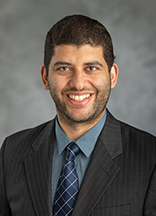
Q: What do you do at the University of Michigan, specifically at the Program for Neurology Research & Discovery?
Dr. Stino: Assistant Professor, Department of Neurology, Michigan Medicine
Director, Peripheral Neuropathy Clinic
Co-Director, Autonomic Lab
Q: Tell us about the focus of your research?
Dr. Stino: My research focuses on the evaluation of drug therapies and outcome measures in patients with autoimmune neuropathy, both through investigator-initiated and multi-center work. In addition, I also look at the reversal of neurodegeneration and pain in cryptogenic (of uncertain origin) or metabolic syndrome neuropathy.
Q: What made you interested in this area?
Dr. Stino: I was always intrigued by the capacity of the immune system to induce neuropathic injury, but also for the opportunity afforded by immune therapies to reverse that injury. Guiding patients through diagnosis, therapy, and recovery is one of the greatest pleasures in life.
Q: What do you hope to accomplish at the Program for Neurology Research & Discovery?
Dr. Stino: My hope is to advance the understanding of autoimmune neuropathies, namely our ability to prognosticate, accurately follow, and treat. I am currently leading a phase 1b study evaluating a novel chemotherapeutic agent in anti-MAG neuropathy—a disease that destroys the myelin in nerve tissue–resistant to most treatments.
Q: What is most exciting about coming to work here?
Dr. Stino: It is a great privilege and unique opportunity to work within a framework of neuroscience specialists who are united in their passion and ability to bridge the bench-to-bedside divide through translational and clinical research. In particular, I am very fortunate to work alongside great and caring individuals, such as Dr. Feldman, who I consider a friend and mentor. Research done at Michigan impacts the world. For example, the field of metabolic syndrome neuropathy was largely the product of research done here at the University of Michigan, and it’s terrific to know that I am contributing in some way to advancing the field.
Q: Where did you go to school and train?
Dr. Stino: B.S., Brain, Behavioral & Cognitive Science, University of Michigan, 2006
M.D., Wayne State University School of Medicine, 2010
Residency, Adult Neurology, Detroit Medical Center – Wayne State University, 2014
Fellowship, Clinical Neurophysiology and Neuromuscular Medicine, Mayo Clinic, 2015
Most recently I was at Ohio State University as the Director of the Peripheral Neuropathy Clinic and as Director the Autonomic Lab.
Q: Have you received any awards?
Dr. Stino: I was awarded the William Branstrom Freshman Prize as an undergraduate at the University of Michigan, given to the top 5% of the entering freshman class. I had the choice of any book as my reward and I chose the Dorland’s Illustrated Medical Dictionary, which no doubt, piqued my interest in medicine.
Q: Where did you grow up? Tell us a little bit about your background.
Dr. Stino: I grew up most of my life in Ann Arbor. I also spent some time in Dubai, United Arab Emirates, as well as Cairo, Egypt. My international upbringing certainly made me open to the possibilities of different lived experiences and the beauty of pluralism and tolerance. It’s made me more understanding to people of differing backgrounds, but also more appreciative of the gem of a town that we call Ann Arbor.
Q: How do you like to spend your time when you aren’t working?
Dr. Stino: I enjoy traveling to foreign destinations, going on mid-western road-trips, playing tennis and golf, spending time with extended family, and reading books on history, politics, and influential historical figures.
Q: Tell us something unusual or interesting about yourself?
Dr. Stino: I have memorized most of the capitals of countries in the world.
